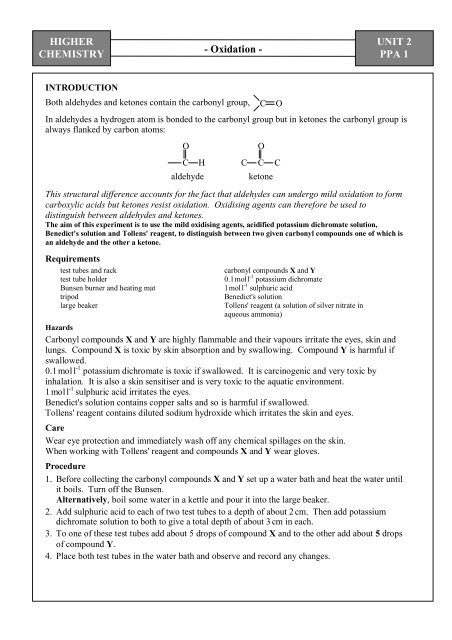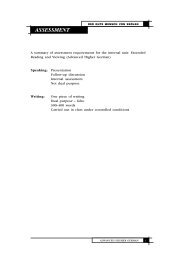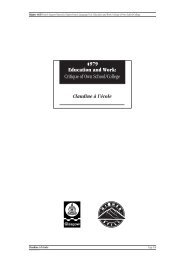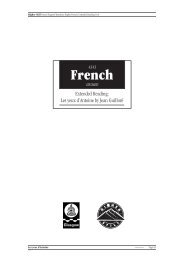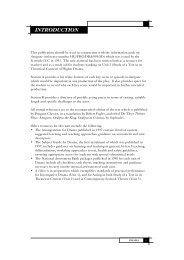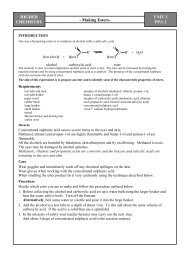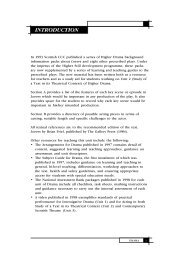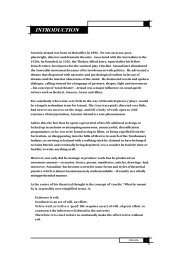HIGHER CHEMISTRY - Oxidation - Education Scotland
HIGHER CHEMISTRY - Oxidation - Education Scotland
HIGHER CHEMISTRY - Oxidation - Education Scotland
You also want an ePaper? Increase the reach of your titles
YUMPU automatically turns print PDFs into web optimized ePapers that Google loves.
<strong>HIGHER</strong><br />
<strong>CHEMISTRY</strong><br />
- <strong>Oxidation</strong> -<br />
UNIT 2<br />
PPA 1<br />
INTRODUCTION<br />
Both aldehydes and ketones contain the carbonyl group, C O<br />
In aldehydes a hydrogen atom is bonded to the carbonyl group but in ketones the carbonyl group is<br />
always flanked by carbon atoms:<br />
O<br />
C H C C C<br />
aldehyde ketone<br />
This structural difference accounts for the fact that aldehydes can undergo mild oxidation to form<br />
carboxylic acids but ketones resist oxidation. Oxidising agents can therefore be used to<br />
distinguish between aldehydes and ketones.<br />
The aim of this experiment is to use the mild oxidising agents, acidified potassium dichromate solution,<br />
Benedict's solution and Tollens' reagent, to distinguish between two given carbonyl compounds one of which is<br />
an aldehyde and the other a ketone.<br />
Requirements<br />
test tubes and rack carbonyl compounds X and Y<br />
test tube holder 0.1 mol l -1 potassium dichromate<br />
Bunsen burner and heating mat 1 mol l -1 sulphuric acid<br />
tripod Benedict's solution<br />
large beaker Tollens' reagent (a solution of silver nitrate in<br />
aqueous ammonia)<br />
Hazards<br />
Carbonyl compounds X and Y are highly flammable and their vapours irritate the eyes, skin and<br />
lungs. Compound X is toxic by skin absorption and by swallowing. Compound Y is harmful if<br />
swallowed.<br />
0.1 mol l -1 potassium dichromate is toxic if swallowed. It is carcinogenic and very toxic by<br />
inhalation. It is also a skin sensitiser and is very toxic to the aquatic environment.<br />
1 mol l -1 sulphuric acid irritates the eyes.<br />
Benedict's solution contains copper salts and so is harmful if swallowed.<br />
Tollens' reagent contains diluted sodium hydroxide which irritates the skin and eyes.<br />
Care<br />
Wear eye protection and immediately wash off any chemical spillages on the skin.<br />
When working with Tollens' reagent and compounds X and Y wear gloves.<br />
Procedure<br />
1. Before collecting the carbonyl compounds X and Y set up a water bath and heat the water until<br />
it boils. Turn off the Bunsen.<br />
Alternatively, boil some water in a kettle and pour it into the large beaker.<br />
2. Add sulphuric acid to each of two test tubes to a depth of about 2 cm. Then add potassium<br />
dichromate solution to both to give a total depth of about 3 cm in each.<br />
3. To one of these test tubes add about 5 drops of compound X and to the other add about 5 drops<br />
of compound Y.<br />
4. Place both test tubes in the water bath and observe and record any changes.<br />
O
<strong>HIGHER</strong><br />
<strong>CHEMISTRY</strong><br />
- <strong>Oxidation</strong> -<br />
UNIT 2<br />
PPA 1<br />
5. Add Benedict's solution to each of two test tubes to a depth of about 3 cm.<br />
6. Repeat steps 3 and 4.<br />
7. Add Tollens' reagent to each of two very clean test tubes to a depth of about 3 cm.<br />
8. Repeat steps 3 and 4 and immediately after, wash the contents of the test tubes down the drain<br />
with large amounts of water.
<strong>HIGHER</strong><br />
<strong>CHEMISTRY</strong><br />
Name:<br />
Date:<br />
* State the aim of the experiment.<br />
PC(b)<br />
- <strong>Oxidation</strong> -<br />
PC(a) PC(b) PC(c) PC(d) PC(e)<br />
- ASSESSMENT SHEET -<br />
* Why can mild oxidising agents be used to distinguish between aldehydes and ketones?<br />
Procedure<br />
* Why were the reaction mixtures not heated directly using a Bunsen burner?<br />
PC(b)<br />
Teacher’s/Lecturer’s<br />
Initials<br />
UNIT 2<br />
PPA 1
<strong>HIGHER</strong><br />
<strong>CHEMISTRY</strong><br />
Results<br />
* Record your observations in tabular form.<br />
PC(c)<br />
CONCLUSION<br />
* State the conclusion of the experiment.<br />
PC(e)<br />
- <strong>Oxidation</strong> -<br />
UNIT 2<br />
PPA 1
<strong>HIGHER</strong><br />
<strong>CHEMISTRY</strong><br />
Reagents<br />
compound X (~ 1 cm 3 )<br />
(propanal)<br />
compound Y (~ 1 cm 3 )<br />
(propanone)<br />
- <strong>Oxidation</strong> -<br />
- TEACHER/LECTURER/TECHNICIAN SHEET -<br />
Requirements per student (or group)<br />
0.1 mol l -1 potassium dichromate (~ 2 cm 3 )<br />
(29.4 g potassium dichromate per litre)<br />
1 mol l -1 sulphuric acid (~ 4 cm 3 )<br />
(55 cm 3 concentrated sulphuric acid per litre)<br />
Benedict's solution (~ 6 cm 3 )<br />
TOLLENS' REAGENT (~ 6 CM 3 )<br />
(Tollens' reagent must be prepared just prior<br />
to its use.<br />
To 5 cm 3 of 0.05 mol l -1 silver nitrate add<br />
about 5 drops of 2 mol l -1 sodium hydroxide.<br />
Then add 2 mol l -1 ammonia solution drop by<br />
drop until the precipitate just dissolves)<br />
APPARATUS<br />
test tubes (6)<br />
test tube rack (1)<br />
test tube holder (1)<br />
Bunsen burner(1)<br />
heating mat (1)<br />
tripod (1)<br />
400 cm 3 glass beaker (1)<br />
compound X<br />
propanal<br />
compound Y<br />
propanone<br />
irritant<br />
0.1 mol l -1 potassium dichromate<br />
potassium dichromate<br />
1 mol l -1 sulphuric acid<br />
concentrated sulphuric<br />
acid<br />
UNIT 2<br />
PPA 1<br />
highly<br />
flammable<br />
highly<br />
flammable<br />
toxic<br />
irritant<br />
corrosive<br />
Benedict's<br />
solution harmful<br />
Tollens' reagent<br />
2 mol l -1 sodium hydroxide<br />
explosive<br />
corrosive
<strong>HIGHER</strong><br />
<strong>CHEMISTRY</strong><br />
Safety Measures<br />
- <strong>Oxidation</strong> -<br />
Preparation/provision of: Main Hazards Control Measures<br />
1 mol l -1 sulphuric acid from<br />
concentrated acid<br />
0.1 mol l -1 potassium<br />
dichromate from solid<br />
Concentrated acid causes severe<br />
burns to eyes and skin.<br />
Toxic by ingestion.<br />
Carcinogenic and very toxic by<br />
inhalation.<br />
Skin sensitiser.<br />
Very toxic to the aquatic<br />
environment.<br />
Benedict's solution Harmful by ingestion owing to<br />
copper salts.<br />
Tollens' reagent Both 2 mol l -1 sodium hydroxide and<br />
solid silver nitrate are corrosive.<br />
propanal Highly flammable (fl. pt. 15 °C).<br />
Toxic by skin absorption and by<br />
ingestion.<br />
Vapour is harmful and irritates eyes,<br />
skin and lungs.<br />
propanone Highly flammable (fl. pt. -20 °C).<br />
Low toxicity but harmful by<br />
ingestion.<br />
Vapour irritates eyes, skin and<br />
lungs.<br />
Notes<br />
UNIT 2<br />
PPA 1<br />
Wear goggles or faceshield and pvc<br />
gloves. Add concentrated acid<br />
slowly with stirring to chilled water<br />
of volume equal to about half the<br />
final volume.<br />
Wear eye protection and nitrile<br />
gloves.<br />
Because of coarse granular nature of<br />
crystals it is easy to prepare solution<br />
without forming a dust aerosol.<br />
Wear eye protection. If prepared<br />
see recipe in Hazardous Chemicals<br />
Manual.<br />
Wear eye protection and gloves.<br />
Must be prepared immediately<br />
before use.<br />
Wear eye protection and nitrile<br />
gloves.<br />
Dispense in fume cupboard or in<br />
well-ventilated room. Supply in<br />
small reagent bottles (50 or 100<br />
cm 3 ).<br />
Wear eye protection and nitrile<br />
gloves.<br />
Dispense in fume cupboard or in<br />
well-ventilated room.<br />
This experiment should be carried out in a well-ventilated room.<br />
Propanal has been recommended as the aldehyde rather than ethanal since the latter is<br />
more volatile and is a carcinogen.<br />
Glucose solution could be used in place of propanal - it gives a better 'silver mirror' test.<br />
It is important that the Tollens' reagent be prepared just prior to its being used since it<br />
becomes explosive on evaporation. For the same reason residues must be washed down<br />
the drain with copious amounts of water.<br />
Fehling's solutions No. 1 (harmful) and No. 2 (corrosive) can be used as an alternative to<br />
Benedict's solution.<br />
Sandell's reagent can also be used as a substitute for Benedict's solution. Its preparation is<br />
described in the Hazardous Chemicals Manual under Fehling's solutions No. 1 and No. 2.


